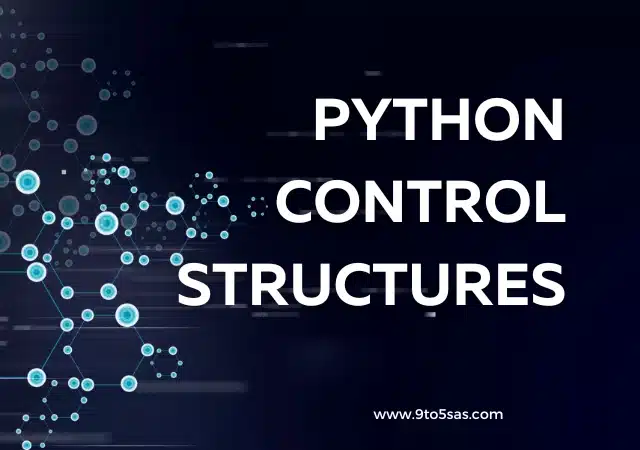Python Control Structures are fundamental elements in Python, helping dictate the flow of program execution. They are the building blocks that allow programs to make decisions and repeat actions.
Python, despite its age, remains a top language due to its simplicity and the robust standard library it provides. Refer to the Python history for more information.
Control structures shape the journey of a program’s execution. They are essential to implement simple tasks, such as data validation, and complex ones, such as building intricate algorithms.
Types of Python Control Structures
There are three types of control structures in Python:
- Sequential Control Structure
- Selection Control Structure
- Repetition Control Structure
Sequential Control Structures
Sequential Control Structure refers to executing commands sequentially, one after the other.
A simple example of a sequential control structure is a series of print statements:
print("This is line one.")
print("This is line two.")This is line one. This is line two.
Each statement runs in the order written, line by line.
Sequential structures are ubiquitous, seen in basic database queries, ETL (Extract, Transform, Load) processes, or even simple scripts for file manipulation.
Selection Control Structures
Selection Control Structures are used when there is a need to select a specific set of instructions out of multiple sets.
The ‘if’ Statement
One of the primary control structures in programming for selection is the “if” statement. It allows the program to execute a specific code block if a particular condition is met. This helps to make the program more efficient and effective by enabling it to respond dynamically to changing circumstances.
Here is an example:
x = 10
if x > 5:
print("x is greater than 5.")x is greater than 5.
The ‘if-else’ Statement
The ‘if-else’ statement is a conditional statement that allows a program to execute different sets of code depending on whether a particular condition is met. It is an extension of the basic ‘if’ statement and can be used to create more complex decision-making structures in a program.
See the example below:
x = 3
if x > 5:
print("x is greater than 5.")
else:
print("x is not greater than 5.")x is not greater than 5.
The ‘if-elif-else’ Statement
When faced with the need to process multiple conditions, the ‘if-elif-else’ structure can be utilized. This programming construct allows for an efficient and organized approach to managing various scenarios. By implementing this structure, the program can accurately evaluate each condition and execute the appropriate code block, resulting in a more streamlined and effective program.
x = 10
if x > 10:
print("x is greater than 10.")
elif x == 10:
print("x equals 10.")
else:
print("x is less than 10.")x equals 10.
Switch-Case Equivalent in Python
Python doesn’t inherently support switch-case statements like some other languages (such as Java or C++), but similar functionality can be achieved using Python’s data types, especially dictionaries and functions.
The Dictionary Method
One common way to replicate switch-case in Python is through dictionary mapping. Each case corresponds to a dictionary key, and the action for each case is represented by the key’s value. For instance:
def switch_case_dict(value):
return {
'case1': "This is case 1",
'case2': "This is case 2",
}.get(value, "This is the default case")
print(switch_case_dict('case1')) # Output: This is case 1
print(switch_case_dict('caseX')) # Output: This is the default caseThis is case 1 This is the default case
In this example, ‘case1’ and ‘case2’ correspond to specific cases, and if the value doesn’t match any defined cases, then the get() method provides a default case.
The Function Method
Another way to create a switch-case-like construct is to use functions or methods. This is a more dynamic approach, particularly when you want to perform complex operations for each case.
def case1_action():
return "This is case 1"
def case2_action():
return "This is case 2"
def default_action():
return "This is the default case"
def switch_case_func(value):
return {
'case1': case1_action,
'case2': case2_action,
}.get(value, default_action)()
print(switch_case_func('case1')) # Output: This is case 1
print(switch_case_func('caseX')) # Output: This is the default caseThis is case 1 This is the default case
In this example, ‘case1’ and ‘case2’ are mapped to specific functions, and if the value doesn’t match any of the cases, the default function is invoked. This method can manage more complex use cases, as each case is associated with a function that can contain multiple lines of code.
Selection control structures find wide use, from basic tasks like user input validation to algorithmic decision-making in complex systems like recommendation engines or artificial intelligence algorithms.
Repetition Control Structures
Repetition Control Structures help in performing a task repeatedly until a certain condition is met.
The ‘for’ loop
When we already know how many times, we want a certain action to be repeated, we can utilize the ‘for’ loop to execute the code block for the predetermined number of iterations.
Here’s a simple demonstration:
for i in range(5):
print("This is iteration number", i)This is iteration number 0 This is iteration number 1 This is iteration number 2 This is iteration number 3 This is iteration number 4
The ‘while’ Loop
The ‘while’ loop is a programming structure that allows for the execution of a set of instructions repeatedly until a certain condition is met. This type of loop is particularly useful when the exact number of iterations needed to fulfil a task is not known beforehand.
See the example:
x = 5
while x > 0:
print("x equals", x)
x -= 1x equals 5 x equals 4 x equals 3 x equals 2 x equals 1
Loop Control Statements: break, continue, pass
break’, ‘continue’, and ‘pass’ is used to fine-tune loops. ‘break’ is used to exit a loop prematurely, ‘continue’ is used to skip to the next iteration, and ‘pass’ is used as a placeholder when syntax requires a statement. Find detailed explanations and examples in this tutorial.
break:
The break statement is used to prematurely exit a loop. When met, it immediately terminates the loop, and the program continues executing the code after the loop. This statement is often used when a certain condition is met, and there’s no need to continue with the remaining iterations.
for num in range(1, 6):
if num == 3:
print("Loop terminated at num =", num)
break
print("Current num:", num)Current num: 1
Current num: 2
Loop terminated at num = 3
In this example, we have a for loop that iterates through numbers 1 to 5. When the loop reaches num == 3, the condition is met, and the break statement is executed. As a result, the loop is immediately terminated, and the program proceeds outside the loop.
continue:
The continue statement skips the current iteration and jumps to the next iteration of the loop. When encountered, it allows you to skip certain parts of the loop’s body based on a condition, but the loop itself continues to execute the subsequent iterations.
for num in range(1, 6):
if num == 3:
print("Skipping num =", num)
continue
print("Current num:", num)Current num: 1 Current num: 2 Skipping num = 3 Current num: 4 Current num: 5
In this example, the for loop iterates through numbers 1 to 5. When num == 3, the condition is met, and the continue statement is executed. As a result, the loop skips printing “Current num: 3” and proceeds to the next iteration.
pass:
The pass statement is a null operation in Python. It does nothing when executed and is used as a placeholder when syntactically a statement is required, but no action needs to be taken.
for num in range(1, 6):
if num == 3:
print("This is num =", num)
else:
passThis is num = 3
In this example, we use the pass as a placeholder in the else part of the if-else statement. When num is not equal to 3, nothing specific needs to be done, so we use pass.
Although the output seems incomplete, it is expected since we have intentionally left the else part blank with the pass statement.
Loop control statements provide programmers with powerful tools to modify the flow of loops according to specific requirements. With the break, continue, and pass,
Repetition structures are used in tasks like data collection, data cleaning, training machine learning models, and more.
Exception Handling in Python
Exception handling is another form of control structure that manages errors or exceptions that occur during program execution.
Exception handling is critical for preventing crashes and handling errors gracefully. It helps maintain smooth user experiences and prevents loss of data or state.
‘Try-except’ Structure
When writing computer programs, the ‘try-except’ structure is a crucial tool used to detect and manage errors or exceptions that may occur during program execution. This structure enables developers to write code that prepares for potential issues and manages them in a smooth and graceful manner, resulting in uninterrupted program execution.
Let us take a moment to examine the consequences that can arise from neglecting the implementation of exception handling.

Now let us consider modifying the code to prevent any division by zero errors.
try:
x = 1 / 0
except ZeroDivisionError:
x = 0‘Try-except-else’ Structure
By using the ‘try-except-else’ structure, it becomes possible to execute a block of code with the condition that no exceptions are raised. This structure provides a dependable method for ensuring that the program can execute smoothly without interruption.
For instance:
try:
x = 1 / 2
except ZeroDivisionError:
x = 0
else:
print("No exceptions were thrown.")No exceptions were thrown.
try-except-finally’ Structure
The ‘try-except-finally’ structure is a useful tool for programming. One of its key benefits is that it enables you to include cleanup code within the ‘finally’ block, even if an exception occurs. This ensures that your code is always executed in a safe and efficient manner.
Consider the following:
try:
x = 1 / 2
except ZeroDivisionError:
x = 0
finally:
print("Cleanup code goes here.")Cleanup code goes here.
Exception handling is widely used in all applications to handle unexpected events gracefully, such as network outages, database connection errors, or invalid user inputs.
Advanced Python Control Structures
Python provides advanced control structures like generator expressions and comprehensions.
Generator Expressions
Generators provide a memory-efficient way to handle large data streams.
Here’s an example:
sum_of_squares = sum(i**2 for i in range(10))
print("sum_of_squares")285
In this Python code snippet, we are using a generator expression and the sum () function to calculate the sum of squares for the first ten natural numbers (0 to 9).
Let’s break down the code step by step:
- range (10): The rang
e ()function generates a sequence of numbers from 0 up to (but not including) the specified value. In this case, it generates numbers from 0 to 9. - (i**2 for i in range (10)): This is a generator expression, which is enclosed in parentheses. It is a compact way to create a generator that yields the squares of each number in the range from 0 to 9. For each value
<strong>i</strong>in the range, the expression i**2 calculates the square of that number. - sum (): The su
m ()function takes the generator expression as its argument. It iterates over the generator and calculates the sum of all the elements generated by the expression(i**2 for i in range (10)). - sum_of_squares = The result of the sum of squares is assigned to the variable
sum_of_squares.
When the code is executed, it calculates the sum of squares for the first ten natural numbers and stores the result in the variable sum_of_squares.
The sum of squares is computed as follows:
sum_of_squares = 0^2 + 1^2 + 2^2 + 3^2 + 4^2 + 5^2 + 6^2 + 7^2 + 8^2 + 9^2
= 0 + 1 + 4 + 9 + 16 + 25 + 36 + 49 + 64 + 81
= 285
Therefore, the value of sum_of_squares is 285. It represents the sum of the squares of numbers from 0 to 9. The code efficiently performs this calculation using a generator expression and the sum() function, which are powerful tools for working with sequences and performing aggregate calculations in Python.
List Comprehensions
List comprehension provides a concise and efficient approach to creating lists in a straightforward manner. This method can simplify the code and improve its readability, making it easier for developers to comprehend and maintain. By utilizing list comprehensions, users can easily generate lists with minimal effort, saving time and increasing productivity.
Example:
squares = [i**2 for i in range(10)]
print(squares)In this Python code snippet, we use list comprehension to create a list containing the squares of the first ten natural numbers (0 to 9). Let’s understand how the code works:
- range (10): The ra
nge ()function generates a sequence of numbers from 0 up to (but not including) the specified value. In this case, it generates numbers from 0 to 9. - [i**2 for i in range (10)]: This is a list comprehension, which is a compact and expressive way to create a list based on an expression. For each value
iin the range from 0 to 9, the expression i**2 calculates the square of that number. - squares = The list created by the list comprehension is assigned to the variable
squares.
When the code is executed, it generates a list named squares containing the squares of the first ten natural numbers:
[0, 1, 4, 9, 16, 25, 36, 49, 64, 81]
The squares list holds the following elements: [0, 1, 4, 9, 16, 25, 36, 49, 64, 81], which represent the squares of numbers 0 to 9.
Therefore, the squares list contains the squares of the first ten natural numbers in ascending order: [0, 1, 4, 9, 16, 25, 36, 49, 64, 81].
This concise and efficient code demonstrates the power of list comprehension for creating lists based on simple expressions in Python.
Dictionary Comprehensions
Like list comprehensions, dictionary comprehensions provide a concise way to create dictionaries.
Example:
square_dict = {i: i**2 for i in range(5)}
print(square_dict)In this Python code snippet, we use dictionary comprehension to create a dictionary named square_dict, where keys represent the first five natural numbers (0 to 4), and the corresponding values represent their squares. Let’s break down the code:
- range (5): The ran
ge ()function generates a sequence of numbers from 0 up to (but not including) the specified value. In this case, it generates numbers from 0 to 4. - {i: i**2 for i in range (5)}: This is dictionary comprehension, which is a concise way to create a dictionary based on an expression. For each value
iin the range from 0 to 4, the expression i**2 calculates the square of that number, and it is used as both the key and value in the dictionary. - square_dict = The dictionary created by the dictionary comprehension is assigned to the variable
square_dict.
When the code is executed, it generates a dictionary named square_dict containing the squares of the first five natural numbers as keys and their corresponding squares as values:
{0: 0, 1: 1, 2: 4, 3: 9, 4: 16}
The square_dict dictionary holds the following key-value pairs:
{
0: 0,
1: 1,
2: 4,
3: 9,
4: 16
}
Therefore, square_dict maps the first five natural numbers to their respective squares: {0: 0, 1: 1, 2: 4, 3: 9, 4: 16}.
This elegant and efficient code demonstrates how dictionary comprehensions can be used to build dictionaries based on simple expressions in Python.
Conclusion
Python control structures are fundamental tools for shaping the flow of a program. Mastering them is crucial to becoming a proficient Python programmer. From basics like ‘if’ statements and ‘for’ loops to advanced constructs like generator expressions, Python provides an array of control structures to tackle any programming challenge.
Keep exploring, keep coding, and remember – practice makes perfect. If you’re interested in further learning, consider this comprehensive Python course from Coursera.





